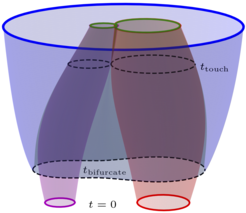What happens “inside” a black-hole merger?
AEI researchers find a new way to visualize a black-hole merger and shed new light on its interior structure
AEI scientists have discovered a new way to visualize and study the merger of black-hole horizons. They show that the well known pair-of-pants picture for event horizons has an analog in quasi-local horizons—the so called marginally outer trapped surfaces (MOTSs)—wherein the two initial MOTSs merge with a highly distorted MOTS that is connected smoothly with the outermost common MOTS. Contrary to previous belief, the horizons do not annihilate in such a MOTS merger but instead continue to exist, start to intersect each other and, surprisingly, even develop self-intersections.
Paper abstract

We find strong numerical evidence for a new phenomenon in a binary black hole spacetime, namely the merger of marginally outer trapped surfaces (MOTSs). By simulating the head-on collision of two non-spinning unequal mass black holes, we observe that the MOTS associated with the final black hole merges with the two initially disjoint surfaces corresponding to the two initial black holes. This yields a connected sequence of MOTSs interpolating between the initial and final state all the way through the non-linear binary black hole merger process. In addition, we show the existence of a MOTS with self-intersections formed immediately after the merger. This scenario now allows us to track physical quantities (such as mass, angular momentum, higher multipoles, and fluxes) across the merger, which can be potentially compared with the gravitational wave signal in the wave-zone, and with observations by gravitational wave detectors. This also suggests a possibility of proving the Penrose inequality mathematically for generic astrophysical binary back hole configurations.












